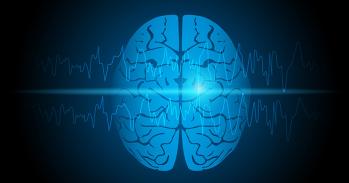
A specific gene expression pattern maps out which parts of the brain are most vulnerable to Alzheimer’s disease, decades before symptoms appear, and helps define the molecular origins of the disease.
A specific gene expression pattern maps out which parts of the brain are most vulnerable to Alzheimer’s disease, decades before symptoms appear, and helps define the molecular origins of the disease.
We wanted to know whether there is something special about the way these proteins behave in vulnerable brain tissue in young individuals, long before the typical age of onset of the disease.
Michele Vendruscolo
Researchers have discovered a gene signature in healthy brains that echoes the pattern in which Alzheimer’s disease spreads through the brain much later in life. The findings, published in the journal Science Advances, could help uncover the molecular origins of this devastating disease, and may be used to develop preventative treatments for at-risk individuals to be taken well before symptoms appear.
The results, by researchers from the University of Cambridge, identified a specific signature of a group of genes in the regions of the brain which are most vulnerable to Alzheimer’s disease. They found that these parts of the brain are vulnerable because the body’s defence mechanisms against the proteins partly responsible for Alzheimer’s disease are weaker in these areas.
Healthy individuals with this specific gene signature are highly likely to develop Alzheimer’s disease in later life, and would most benefit from preventative treatments, if and when they are developed for human use.
Alzheimer’s disease, the most common form of dementia, is characterised by the progressive degeneration of the brain. Not only is the disease currently incurable, but its molecular origins are still unknown. Degeneration in Alzheimer’s disease follows a characteristic pattern: starting from the entorhinal region and spreading out to all neocortical areas. What researchers have long wondered is why certain parts of the brain are more vulnerable to Alzheimer’s disease than others.
“To answer this question, what we’ve tried to do is to predict disease progression starting from healthy brains,” said senior author Professor Michele Vendruscolo of the Centre for Misfolding Diseases at Cambridge’s Department of Chemistry. “If we can predict where and when neuronal damage will occur, then we will understand why certain brain tissues are vulnerable, and get a glimpse at the molecular origins of Alzheimer’s disease.”
One of the hallmarks of Alzheimer’s disease is the build-up of protein deposits, known as plaques and tangles, in the brains of affected individuals. These deposits, which accumulate when naturally-occurring proteins in the body fold into the wrong shape and stick together, are formed primarily of two proteins: amyloid-beta and tau.
“We wanted to know whether there is something special about the way these proteins behave in vulnerable brain tissue in young individuals, long before the typical age of onset of the disease,” said Vendruscolo.
Vendruscolo and his colleagues found that part of the answer lay within the mechanism of control of amyloid-beta and tau. Through the analysis of more than 500 samples of healthy brain tissues from the Allen Brain Atlas, they identified a signature of a group of genes in healthy brains. When compared with tissue from Alzheimer’s patients, the researchers found that this same pattern is repeated in the way the disease spreads in the brain.
“Vulnerability to Alzheimer’s disease isn’t dictated by abnormal levels of the aggregation-prone proteins that form the characteristic deposits in disease, but rather by the weaker control of these proteins in the specific brain tissues that first succumb to the disease,” said Vendruscolo.
Our body has a number of effective defence mechanisms which protect it against protein aggregation, but as we age, these defences get weaker, which is why Alzheimer’s generally occurs in later life. As these defence mechanisms, collectively known as protein homeostasis systems, get progressively impaired with age, proteins are able to form more and more aggregates, starting from the tissues where protein homeostasis is not so strong in the first place.
Earlier this year, the same researchers behind the current study identified a possible ‘neurostatin’ that could be taken by healthy individuals in order to slow or stop the progression of Alzheimer’s disease, in a similar way to how statins are taken to prevent heart disease. The current results suggest a way to exploit the gene signature to identify those individuals most at risk and who would most benefit from taking a neurostatin in earlier life.
Although a neurostatin for human use is still quite some time away, a shorter-term benefit of these results may be the development of more effective animal models for the study of Alzheimer’s disease. Since the molecular origins of the disease have been unknown to date, it has been difficult to breed genetically modified mice or other animals that repeat the full pathology of Alzheimer’s disease, which is the most common way for scientists to understand this or any disease in order to develop new treatments.
“It is exciting to consider that the molecular origins identified here for Alzheimer’s may predict vulnerability for other diseases associated with aberrant aggregation – such as ALS, Parkinson’s and frontotemporal dementia,” said Rosie Freer, a PhD student in the Department of Chemistry and the study’s lead author. “I hope that these results will help drug discovery efforts – that by illuminating the origin of disease vulnerability, there will be a clearer target for those working to cure Alzheimer’s.”
“The results of this particular study provide a clear link between the key factors that we have identified as underlying the aggregation phenomenon and the order in which the effects of Alzheimer’s disease are known to spread through the different regions of the brain,” said study co-author Professor Christopher Dobson, who is Master of St John’s College, Cambridge. “Linking the properties of specific protein molecules to the onset and spread of neuronal damage is a crucial step in the quest to find effective drugs to combat this dreadful neurodegenerative condition, and potentially other diseases related to protein misfolding and aggregation.”
Addressing these problems represents the core programme of research of the Centre for Misfolding Diseases, which is directed by Chris Dobson, Tuomas Knowles and Michele Vendruscolo. The primary mission of the Centre is to develop a fundamental understanding of the molecular origins of the variety of disorders associated with the misfolding and aggregation of proteins, which include Parkinson's disease, ALS and type II diabetes as well as Alzheimer's disease, and then to use such understanding for the rational design of novel therapeutic strategies.
Reference:
R. Freer et. al. ‘A protein homeostasis signature in healthy brains recapitulates tissue vulnerability to Alzheimer’s disease.’ Science Advances (2016). DOI: 10.1126/sciadv.1600947

The text in this work is licensed under a Creative Commons Attribution 4.0 International License. For image use please see separate credits above.




